The Aerosol-Radiation Interaction Effects of Different Particulate Matter Components during Heavy Pollution Periods in China
Abstract
1. Introduction
2. Model Setup
2.1. Model Description
2.2. Simulation Configurations and Design
3. Results and Discussion
3.1. Model Performance
3.2. ARI Effects of Different PM Components
3.2.1. Downward Shortwave Radiation
3.2.2. Temperatures at 2 m
3.2.3. Plant Boundary Layer Height
3.2.4. 2-m Relative Humidity
3.2.5. PM2.5 Concentrations
4. Conclusions
Author Contributions
Funding
Conflicts of Interest
References
- Santos, D.; Costa, M.J.; Silva, A.M. Direct SW aerosol radiative forcing over Portugal. Atmos. Chem. Phys. 2008, 8, 5771–5786. [Google Scholar]
- Dhar, P.; De, B.K.; Banik, T.; Gogoi, M.M.; Babu, S.S.; Guha, A. Atmospheric aerosol radiative forcing over a semi-continental location Tripura in North-East India: Model results and ground observations. Sci. Total Environ. 2017, 580, 499–508. [Google Scholar] [CrossRef] [PubMed]
- Obregón, M.A.; Costa, M.J.; Silva, A.M.; Serrano, A. Impact of aerosol and water vapour on SW radiation at the surface: Sensitivity study and applications. Atmos. Res. 2018, 213, 252–263. [Google Scholar] [CrossRef]
- Charlson, R.J.; Schwartz, S.E.; Hales, J.M.; Cess, R.D.; Coakley, J.A.; Hansen, J.E.; Hofmann, D.J. Climate Forcing by Anthropogenic Aerosols. Science 1992, 255, 423–430. [Google Scholar] [CrossRef] [PubMed]
- Pere, J.C.; Mallet, M.; Pont, V.; Bessagnet, B. Impact of aerosol direct radiative forcing on the radiative budget, surface heat fluxes, and atmospheric dynamics during the heat wave of summer 2003 over western Europe: A modeling study. J. Geophys. Res. Atmos. 2011, 116, D23119. [Google Scholar] [CrossRef]
- Boucher, O.; Randall, D.; Artaxo, P. Clouds and aerosols. In Climate Change 2013: The Physical Science Basis. Contribution of Working Group I to the Fifth Assessment Report of the Intergovernmental Panel on Climate Change; Stocker, T.F., Qin, D., Plattner, G., Tignor, M., Allen, S.K., Boschung, J., Nauels, A., Xia, Y., Bex, V., Midgley, P.M., Eds.; Cambridge University Press: Cambridge, UK; New York, NY, USA, 2013. [Google Scholar]
- Xing, J.; Mathur, R.; Pleim, J.; Hogrefe, C.; Gan, C.M.; Wong, D.C.; Wei, C.; Wang, J.D. Air pollution and climate response to aerosol direct radiative effects: A modeling study of decadal trends across the northern hemisphere. J. Geophys. Res. Atmos. 2015, 120, 12221–12236. [Google Scholar] [CrossRef]
- Guo, J.; Liu, H.; Wang, F.; Huang, J.F.; Xia, F.; Lou, M.Y.; Wu, Y.R.; Jiang, J.H.; Xie, T.; Zhaxi, Y.Z.; et al. Three-dimensional structure of aerosol in China: A perspective from multi-satellite observations. Atmos. Res. 2016, 178, 580–589. [Google Scholar] [CrossRef]
- Dong, C.; Matsui, H.; Spak, S.; Kalafut-Pettibone, A.; Stanier, C. Impacts of New Particle Formation on Short-term Meteorology and Air Quality as Determined by the NPF-explicit WRF-Chem in the Midwestern United States. Atmos. Chem. Phys. 2018, 19, 204. [Google Scholar] [CrossRef]
- IPCC. Climate change 2007: Synthesis Report. In Contribution of Working Group I to the Fourth Assessment Report of the Intergovernmental Panel on Climate Change; Solomon, S., Qin, D., Manning, M., Eds.; Cambridge University Press: Cambridge, UK, 2007. [Google Scholar]
- Ramanathan, V.P.J.; Crutzen, J.T.; Kiehl, D. Rosenfeld. Aerosols, Climate, and the Hydrological Cycle. Sciences 2010, 5549, 2119–2124. [Google Scholar]
- Jacobson, M.Z. Atmospheric Pollution: History, Sciences and Regulation; Cambridge University Press: New York, NY, USA, 2002; 399p, ISBN 0521010446. [Google Scholar]
- Ma, Y.; Xin, J.Y.; Zhang, W.Y.; Liu, Z.R.; Ma, Y.J.; Kong, L.B.; Wang, Y.S.; Deng, Y.; Lin, S.H.; He, Z.M. Long-term variations of the PM2.5 concentration identified by MODIS in the tropical rain forest, Southeast Asia. Atmos. Res. 2019, 219, 140–152. [Google Scholar] [CrossRef]
- MEP. 2017 Air Pollution Prevention and Management Plan for the Beijing-Tianjin-Hebei Region and Its Surrounding Areas. Available online: http://dqhj.mee.gov.cn/dtxx/201703/t20170323_408663.shtml (accessed on 18 August 2018).
- Wen, W.; Cheng, S.Y.; Chen, X.F.; Wang, G.; Li, S.; Wang, X.Q.; Liu, X.Y. Impact of emission control on PM2.5 and the chemical composition change in Beijing-Tianjin-Hebei during the APEC summit 2014. Environ. Sci. Pollut. Res. 2016, 105, 432–436. [Google Scholar] [CrossRef] [PubMed]
- Wang, G.; Cheng, S.Y.; Lang, J.L.; Yang, X.W.; Wang, X.Q.; Chen, G.L.; Liu, X.Y.; Zhang, H.Y. Characteristics of PM2.5 and assessing effects of emission—Reduction measures in the heavy polluted city of Shijiazhuang, before, during, and after the Ceremonial Parade 2015. Aerosol Air Qual. Res. 2017, 17, 499–512. [Google Scholar] [CrossRef]
- Zhang, X.Y.; Wang, Y.Q.; Lin, W.L.; Zhang, Y.M.; Zhang, X.C.; Gong, S.; Zhao, P.; Yang, Y.Q.; Wang, J.Z.; Hou, Q.; et al. Changes of atmospheric composition and optical properties over Beijing 2008 Olympic monitoring Campaign. Bull. Am. Meteorol. Soc. 2009, 90, 1633–1651. [Google Scholar] [CrossRef]
- Wang, T.; Nie, W.; Gao, J.; Xue, L.K.; Gao, X.M.; Wang, X.F.; Qiu, J.; Poon, C.N.; Meinardi, S.; Blake, D.; et al. Air quality during the 2008 Beijing Olympics: Secondary pollutants and regional impact. Atmos. Chem. Phys. 2010, 10, 7603–7615. [Google Scholar] [CrossRef]
- Xu, W.Q.; Sun, Y.L.; Chen, C.; Du, W.; Han, T.T.; Wang, Q.Q.; Fu, P.Q.; Wang, Z.F.; Zhao, X.J.; Zhou, L.B.; et al. Aerosol composition, oxidation properties, and sources in Beijing: Results from the 2014 Asia-Pacific Economic Cooperation summit study. Atmos. Chem. Phys. 2015, 15, 13681–13698. [Google Scholar] [CrossRef]
- Sun, Y.; Wang, Z.F.; Wild, O. “APEC Blue”: Secondary Aerosol Reductions from Emission Controls in Beijing. Sci. Rep. 2016, 6, 20668. [Google Scholar] [CrossRef]
- Makar, P.A.; Gong, W.; Milbrandt, J. Feedbacks between air pollution and weather, Part 1: Effects on weather. Atmos. Environ. 2015, 115, 442–469. [Google Scholar] [CrossRef]
- Forkel, R.; Werhahn, J.; Hansen, A.B.; McKeen, S.; Peckham, S.; Grell, G.; Suppan, P. Effect of Aerosol radiation Feedback on Regional Air Quality—A Case Study with WRF/Chem. Atmos. Environ. 2012, 53, 202–211. [Google Scholar] [CrossRef]
- Giorgi, F.; Bi, X.; Qian, Y. Indirect vs. Direct Effects of Anthropogenic Sulfate on the Climate of East Asia as Simulated with a Regional Coupled Climate Chemistry Aerosol Mode. Clim. Chang. 2003, 58, 345–376. [Google Scholar] [CrossRef]
- Zhuang, B.L.; Liu, L.; Shen, F.H.; Wang, T.J.; Han, Y. Semi-direct Radiative Forcing of Internal Mixed Black Carbon Cloud Droplet and Its Regional Climatic Effect over China. J. Geophys. Res. 2010, 115, D00K19. [Google Scholar] [CrossRef]
- Yang, X. Intensification of aerosol pollution associated with its feedback with surface solar radiation and winds in Beijing. J. Geophys. Res. Atmos. 2016, 121, 4093–4099. [Google Scholar] [CrossRef]
- Quan, J.N.; Tie, X.; Zhang, Q.; Liu, Q.; Li, X.; Gao, Y.; Zhao, D. Characteristics of heavy aerosol pollution during the 2012–2013 winter in Beijing, China. Atmos. Environ. 2014, 88, 83–89. [Google Scholar] [CrossRef]
- Gao, Y. Modeling the feedback between aerosol and meteorological variables in the atmospheric boundary layer during a severe fog-haze event over the North China Plain Atmos. Chem. Phys. 2015, 15, 1093–1130. [Google Scholar]
- Zhou, M.; Zhang, L.; Chen, D.; Gu, Y.; Zhao, B. The impact of aerosol–radiation interactions on the effectiveness of emission control measures. Environ. Res. Lett. 2019, 14, 02400. [Google Scholar] [CrossRef]
- Zaveri, R.A.; Peters, L.K. A new lumped structure photochemical mechanism for large-scale applications. J. Geophys. Res. 1999, 104, 30387–30415. [Google Scholar] [CrossRef]
- Zaveri, R.A.; Easter, R.C.; Fast, J.D.; Peters, L.K. Model for simulating aerosol interactions and chemistry (MOSAIC). J. Geophys. Res. 2008, 113, D13204. [Google Scholar] [CrossRef]
- Thompson, G.; Field, P.R.; Rasmussen, R.M.; Hall, W.D. Explicit forecasts of winter precipitation using an improved bulk microphysics scheme. Part II: Implementation of a new snow parameterization. Mon. Weather Rev. 2008, 136, 5095–5115. [Google Scholar] [CrossRef]
- Chou, M.D.; Suarez, M.J. An Efficient Thermal Infrared Radiation Parameterization for Use in General Circulation Models; NASA Technical Memorandum; NASA Goddard Space Flight Center: Greenbelt, MD, USA, 1994; Volume 3, pp. 1–85.
- Mlawer, E.J.; Taubman, S.J.; Brown, P.D.; Iacono, M.J.; Clough, S.A. Radiative transfer for inhomogeneous atmospheres: RRTM, a validated correlated-k model for the longwave. J. Geophys. Res. 1997, 102, 16663–16682. [Google Scholar] [CrossRef]
- Hong, S.Y.; Noh, Y.; Dudhia, J. A new vertical diffusion package with an explicit treatment of entrainment processes. Mon. Weather Rev. 2006, 134, 2318–2341. [Google Scholar] [CrossRef]
- Fast, J.D.; Gustafson, W.I.; Easter, R.C.; Zaveri, R.A.; Barnard, J.C.; Chapman, E.G.; Grell, G.A.; Peckham, S.E. Evolution of ozone, particulates, and aerosol direct radiative forcing in the vicinity of Houston using a fully coupled meteorology–chemistry–aerosol model. J. Geophys. Res. 2006, 111, D21305. [Google Scholar] [CrossRef]
- Tsinghua University. Multi-resolution Emission Inventory for China. 2016. Available online: http://www.meicmodel.org/ (accessed on 18 June 2019).
- Zhang, Y.; Kristen, M.O.; Wang, K. Fine scale modeling of agricultural air quality over the southeastern united states using two air quality models. Part II. Sensitivity studies and policy implications. Aerosol Air Qual. Res. 2013, 13, 1475–1491. [Google Scholar] [CrossRef]
- US EPA. Guidance on the Use of Models and Other Analyses for Demonstrating Attainment of Air Quality Goals for Ozone, PM2.5, and Regional Haze; U.S. Environmental Protection Agency Office of Air Quality Planning and Standards Air Quality Analysis Division Air Quality Modeling Group Research: Research Triangle Park, NC, USA, 2007.
- Wang, L.T.; Wei, Z.M.; Yang, J.Z.; Zhang, Y.; Zhang, F.F.; Su, J.; Meng, C.C.; Zhang, Q. The 2013 severe haze over southern Hebei, China: Model evaluation, source apportionment, and policy implications. Atmos. Chem. Phys. 2013, 13, 28395–28451. [Google Scholar] [CrossRef]
- Chen, D.S.; Ma, X.; Xie, X.; Wei, P.; Wen, W.; Xu, T.T.; Yang, N.; Gao, Q.X.; Shi, H.D.; Guo, X.R.; et al. Modelling the Effect of Aerosol Feedbacks on the Regional Meteorology Factors over China. Aerosol Air Qual. Res. 2015, 15, 1559–1579. [Google Scholar] [CrossRef]
- Zhang, Y.; Wen, X.Y.; Jang, C.J. Simulating Chemistry-aerosol-cloud-radiation-climate Feedbacks over the Continental, U.S. Using the Online-coupled Weather Research Recasting Model with Chemistry (WRF/Chem). Atmos. Environ. 2010, 44, 3568–3582. [Google Scholar] [CrossRef]
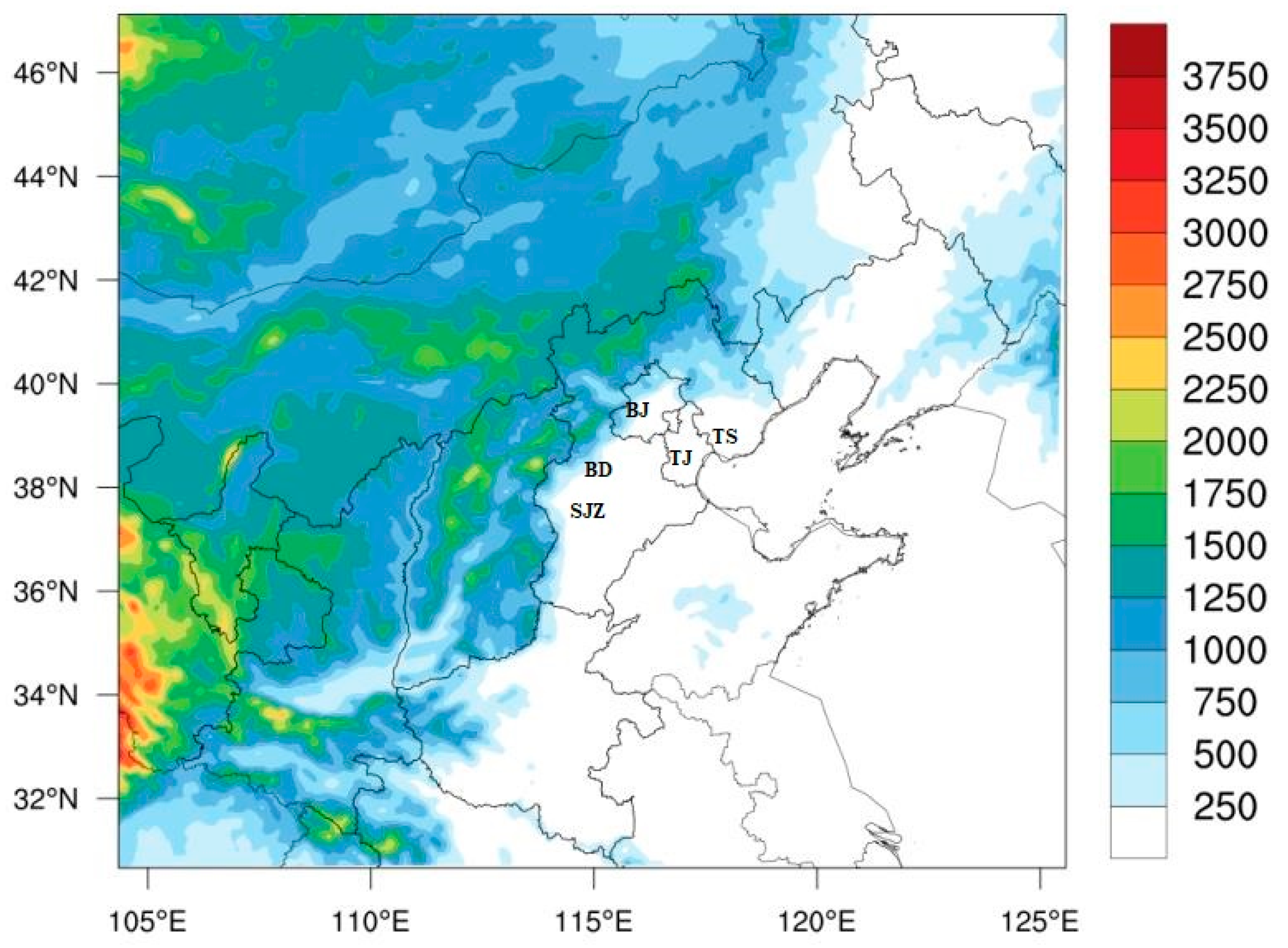
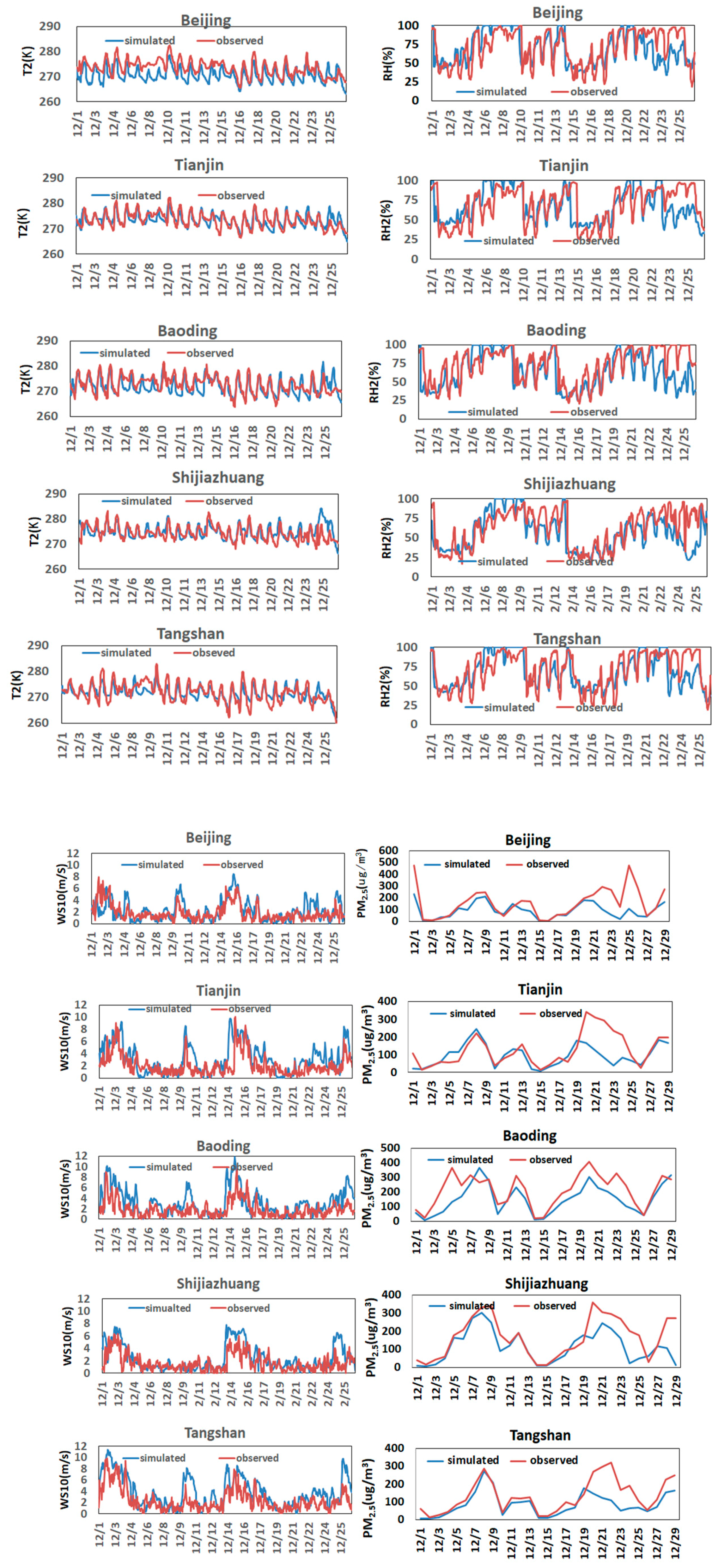
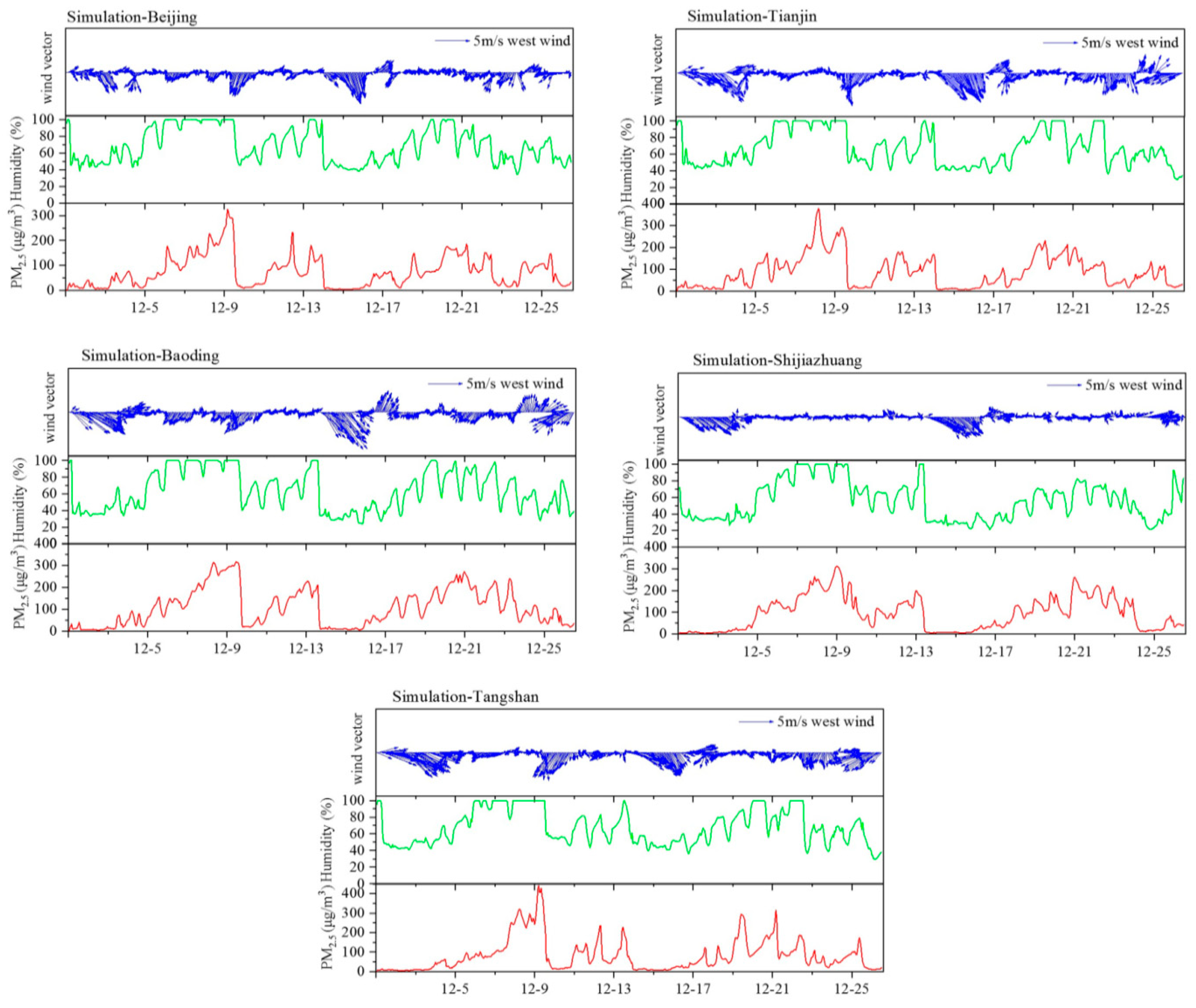
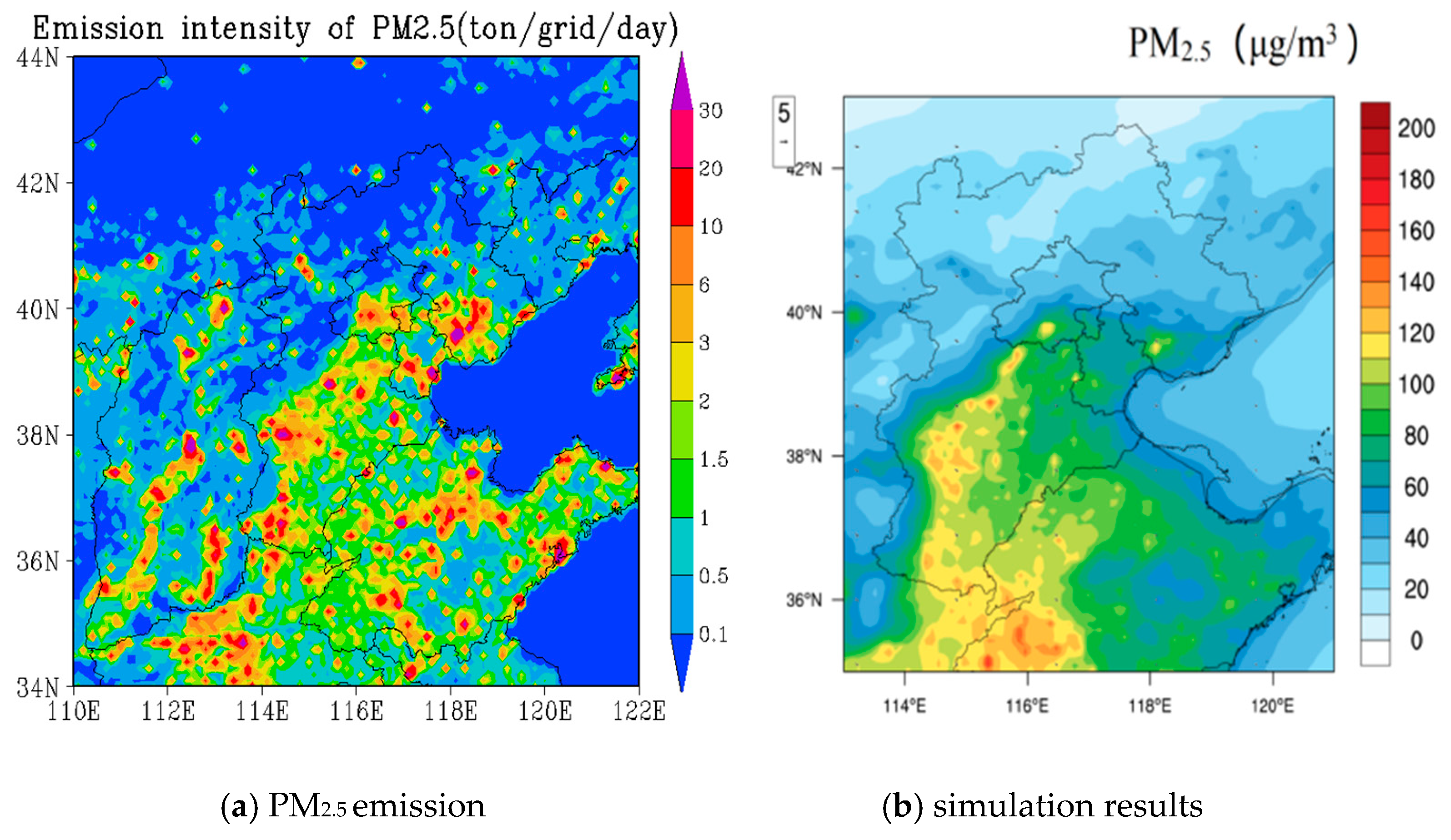
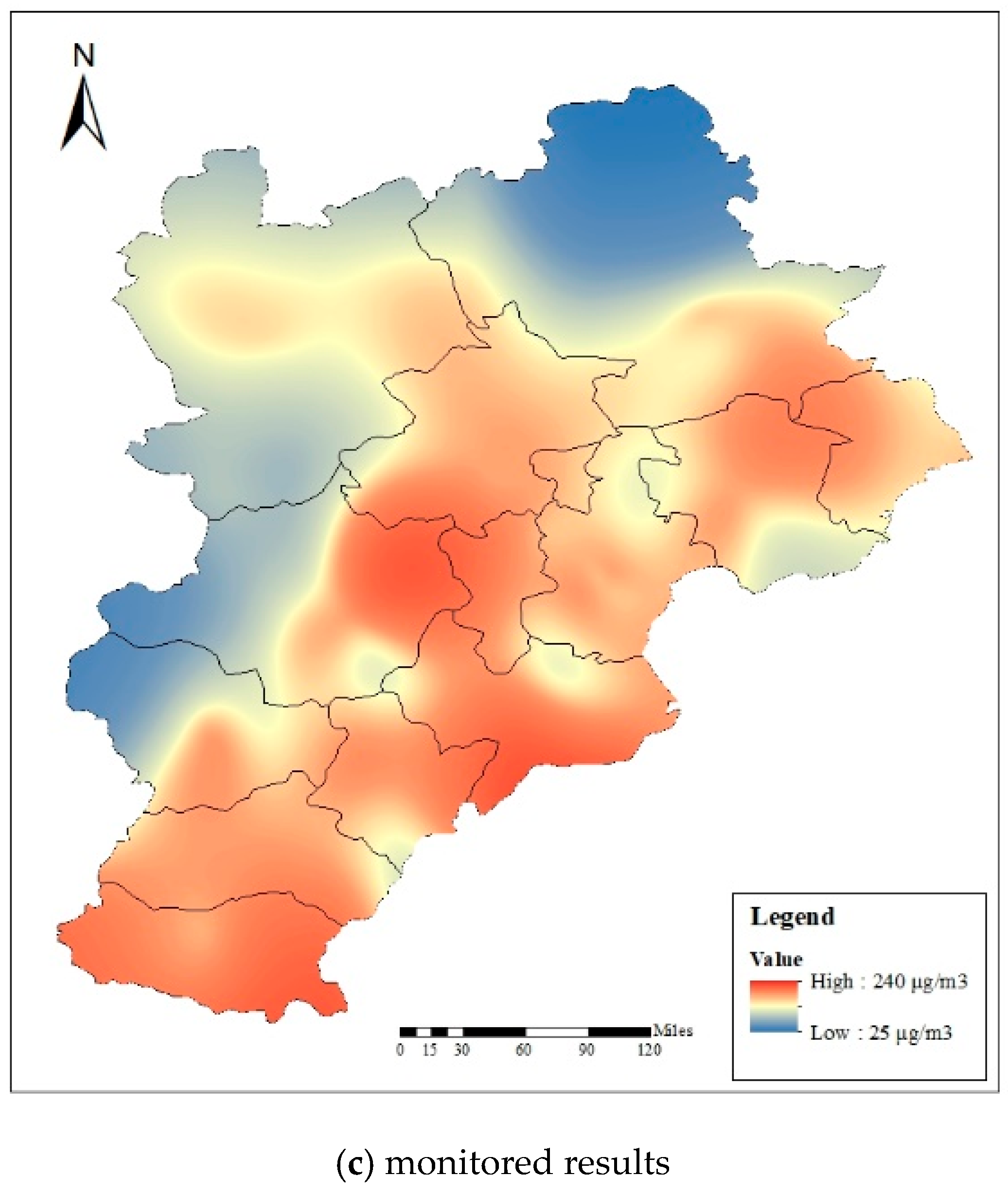
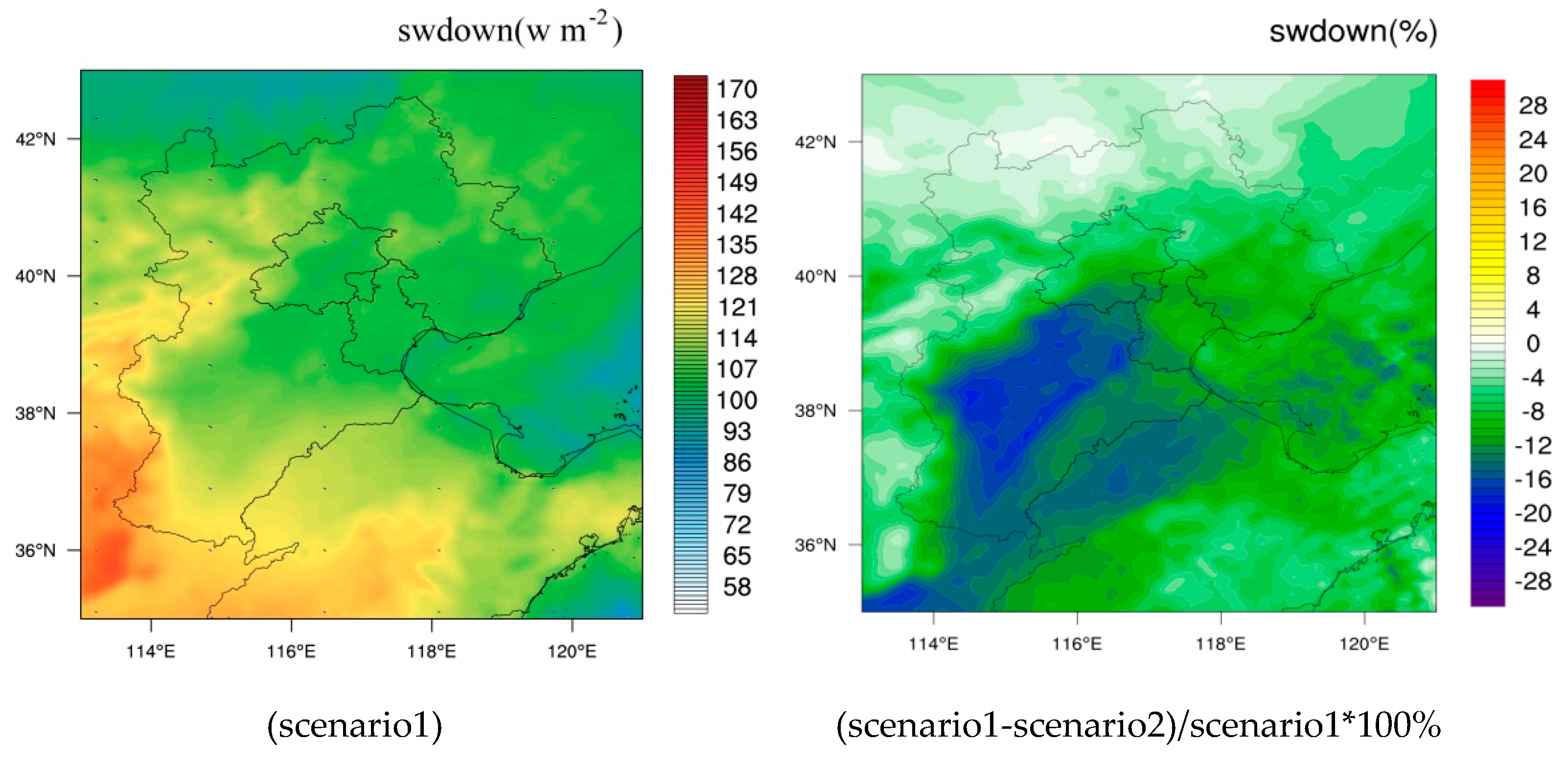
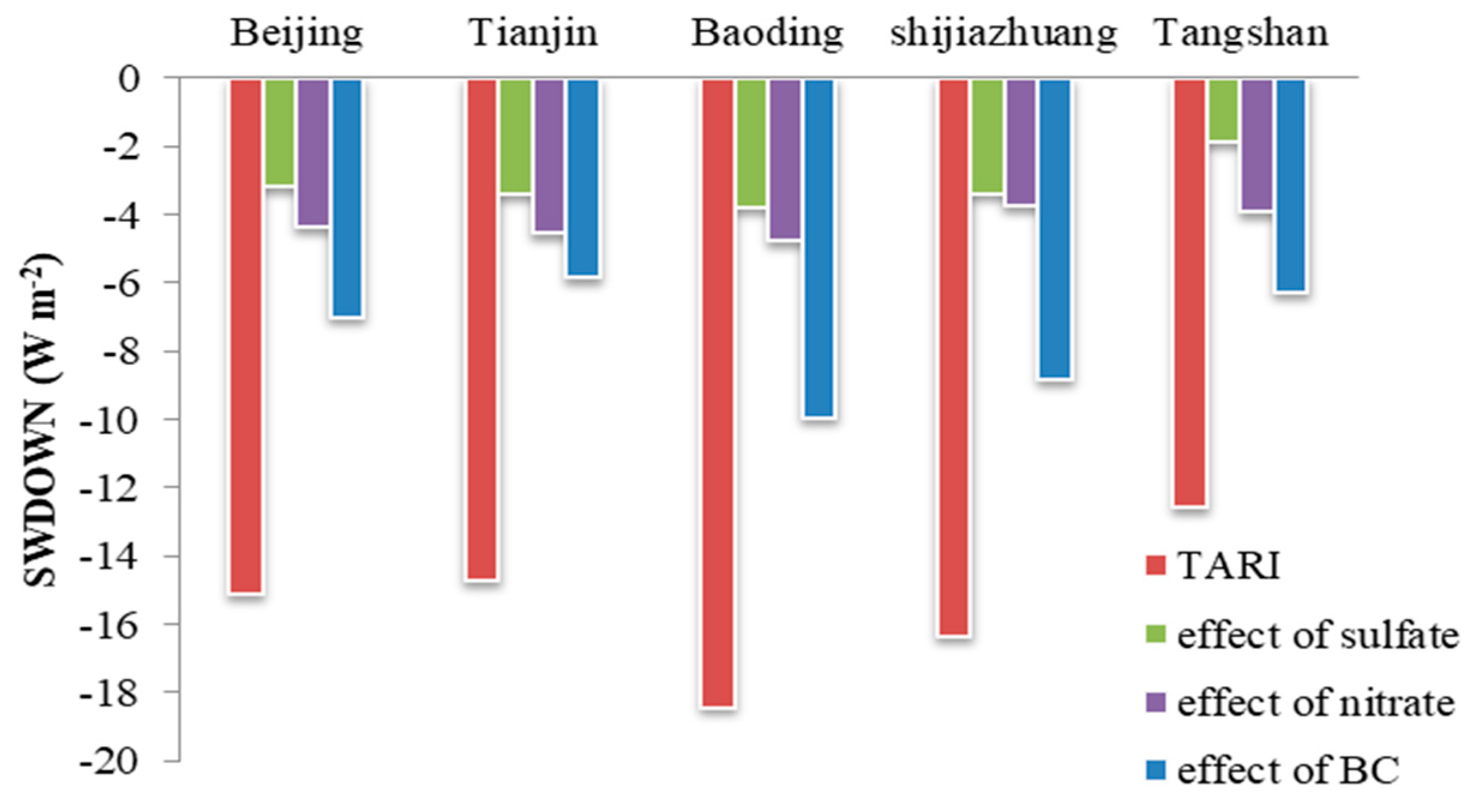
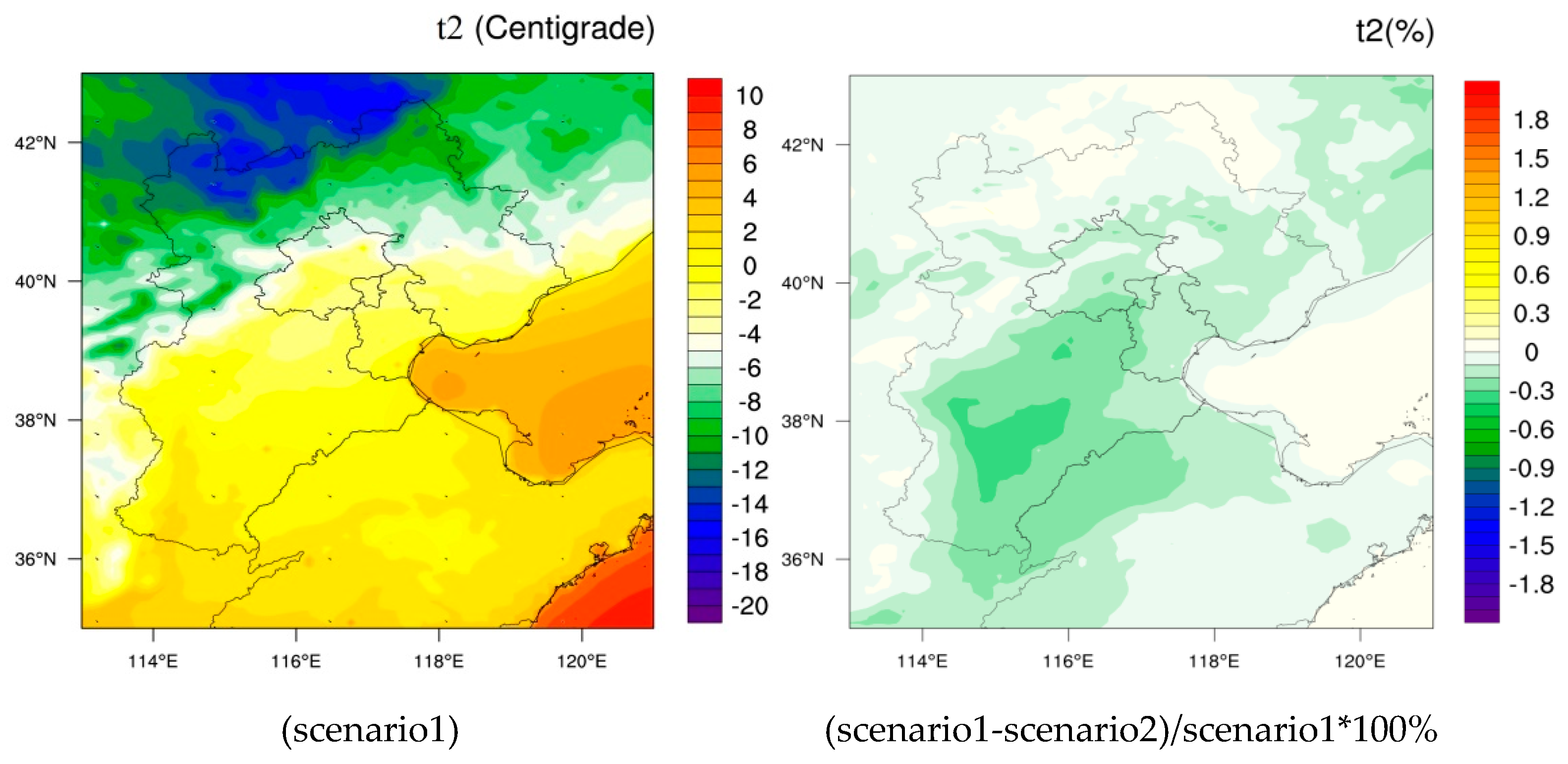
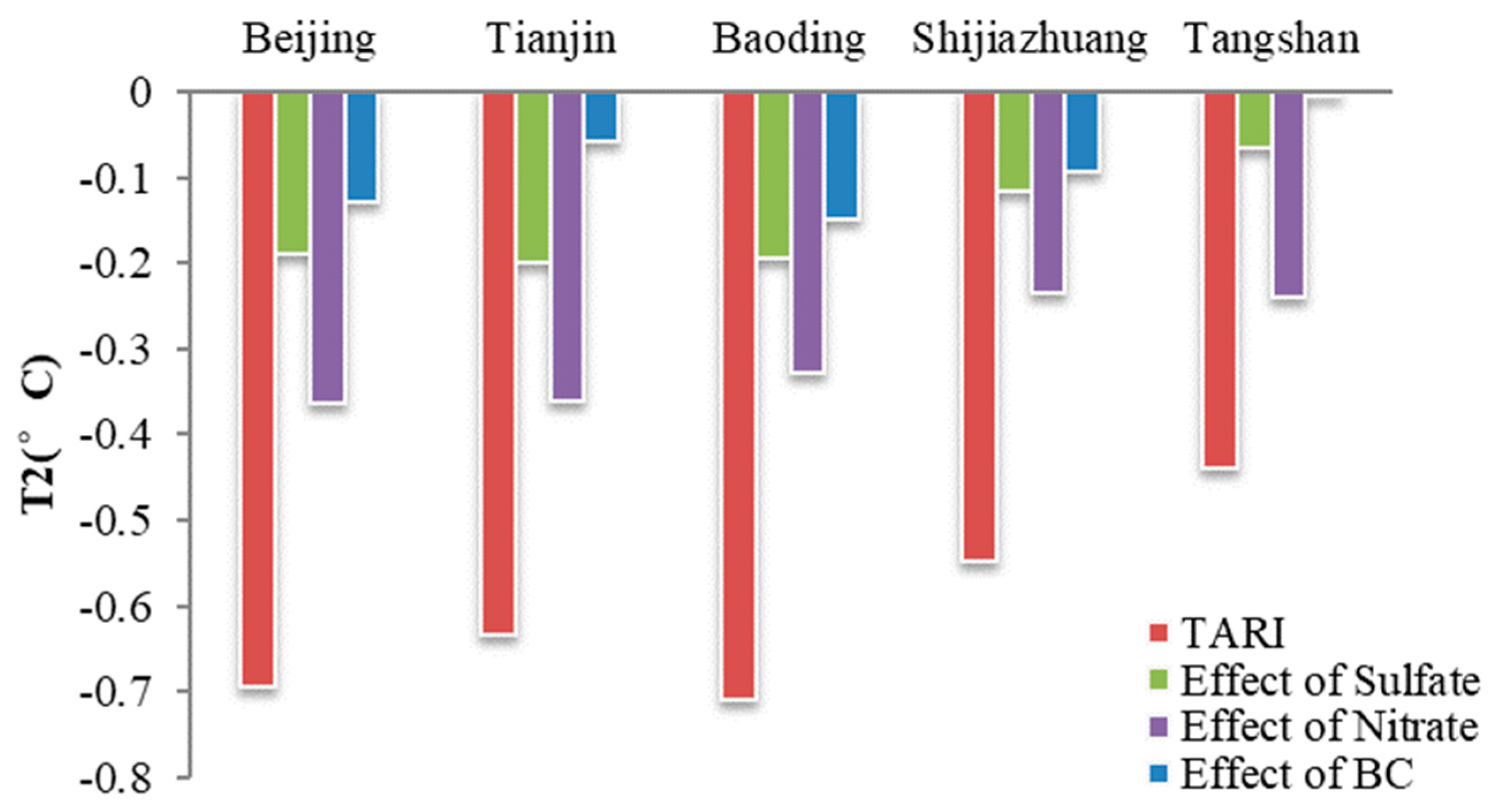
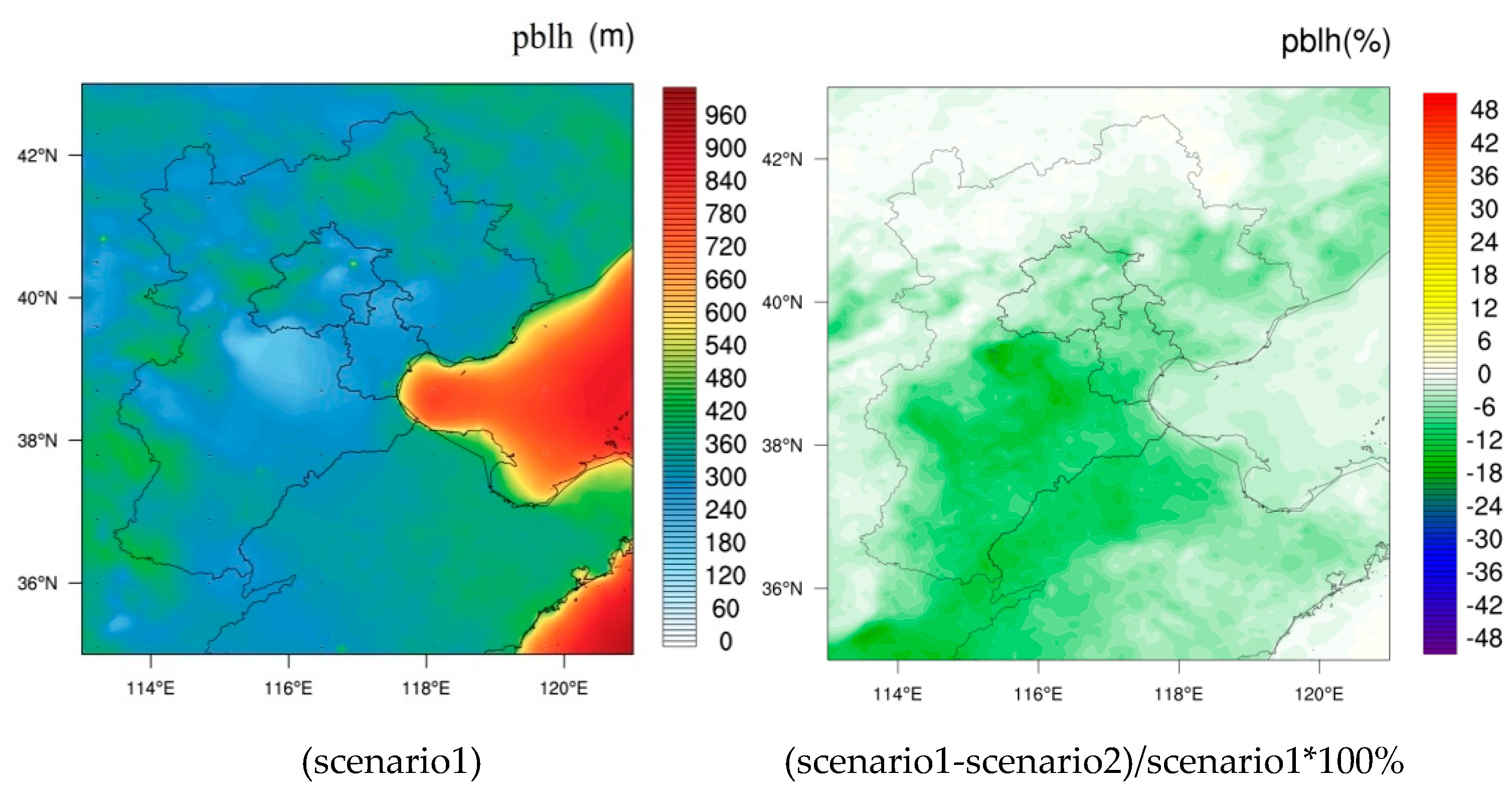
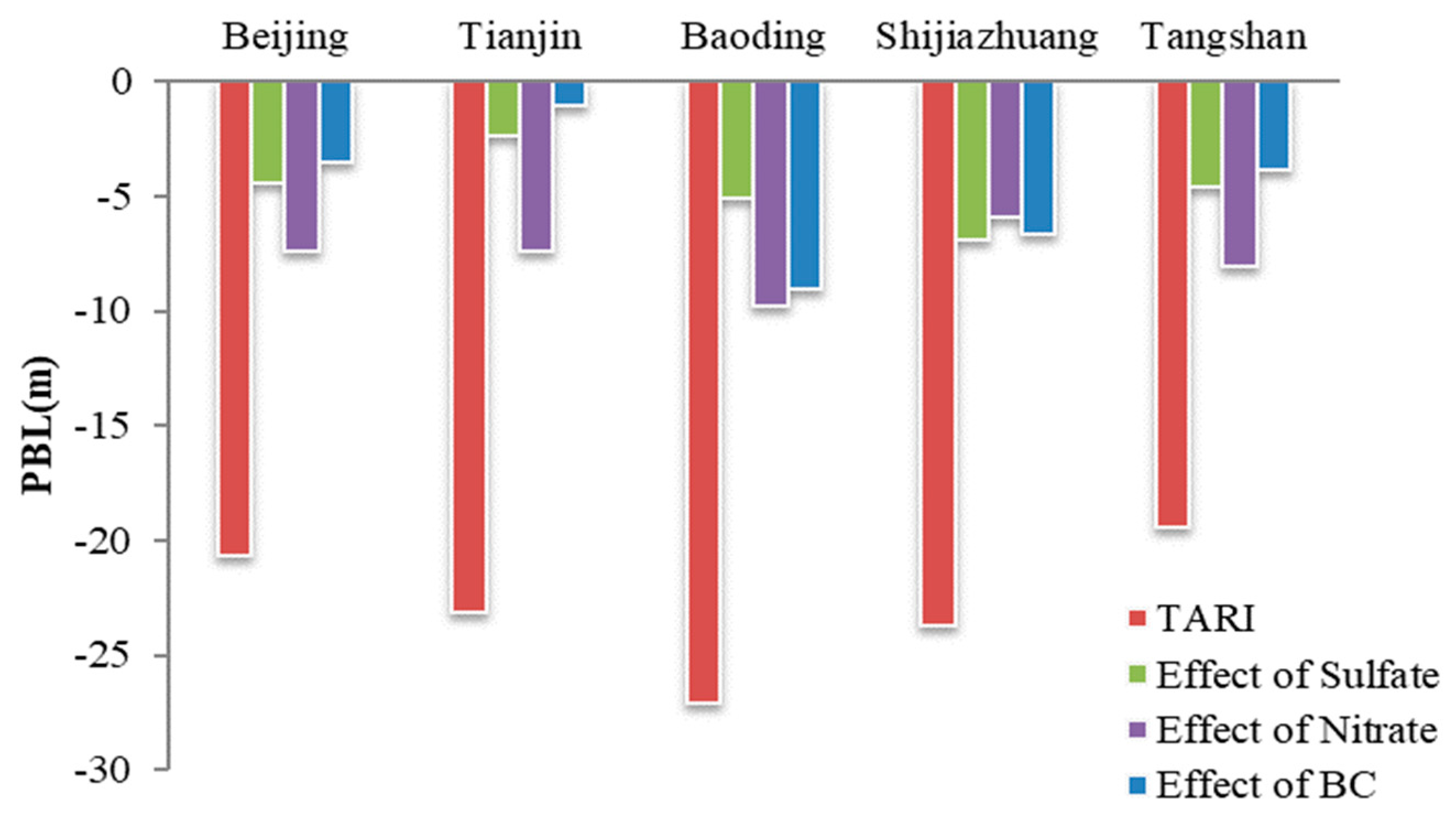
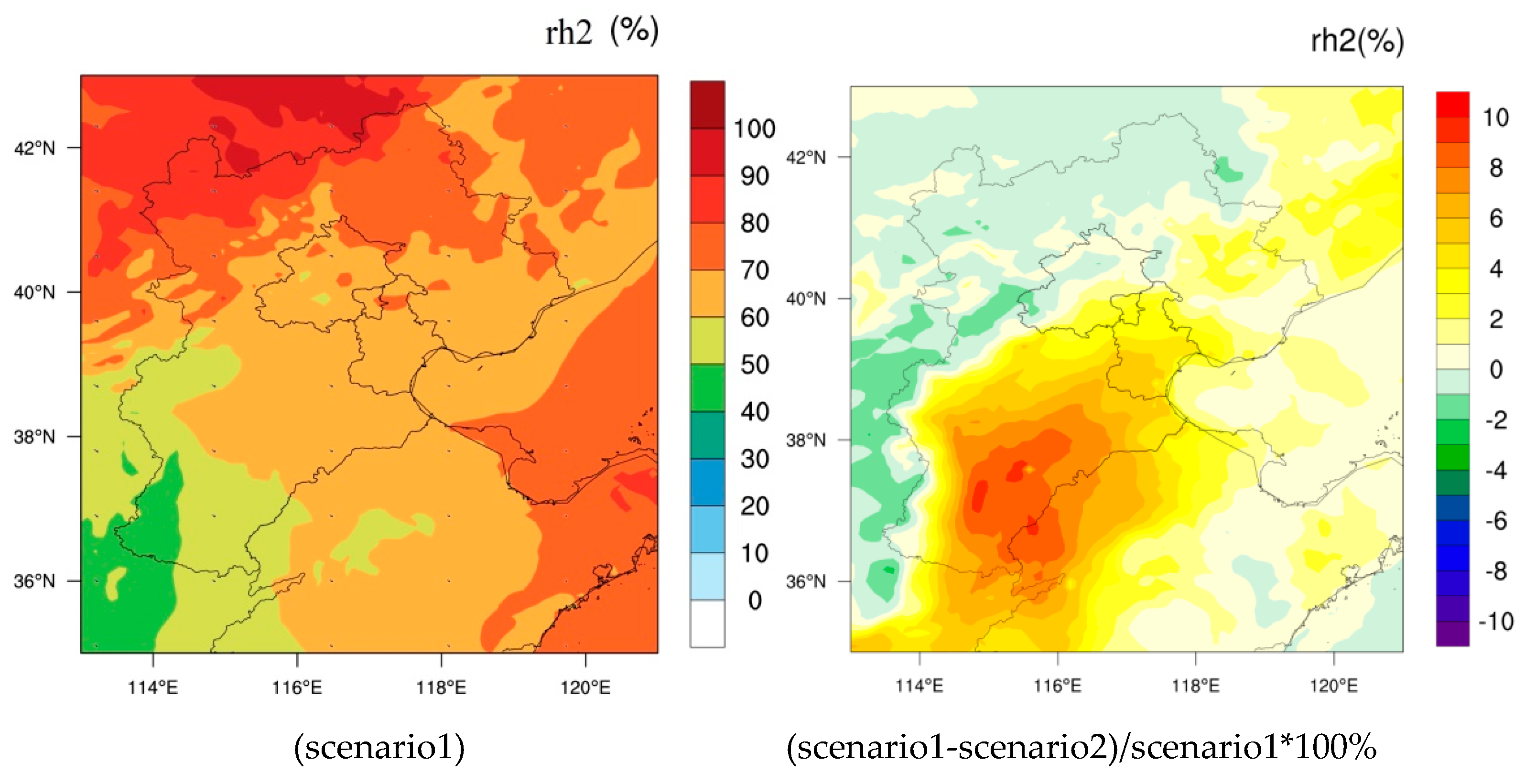
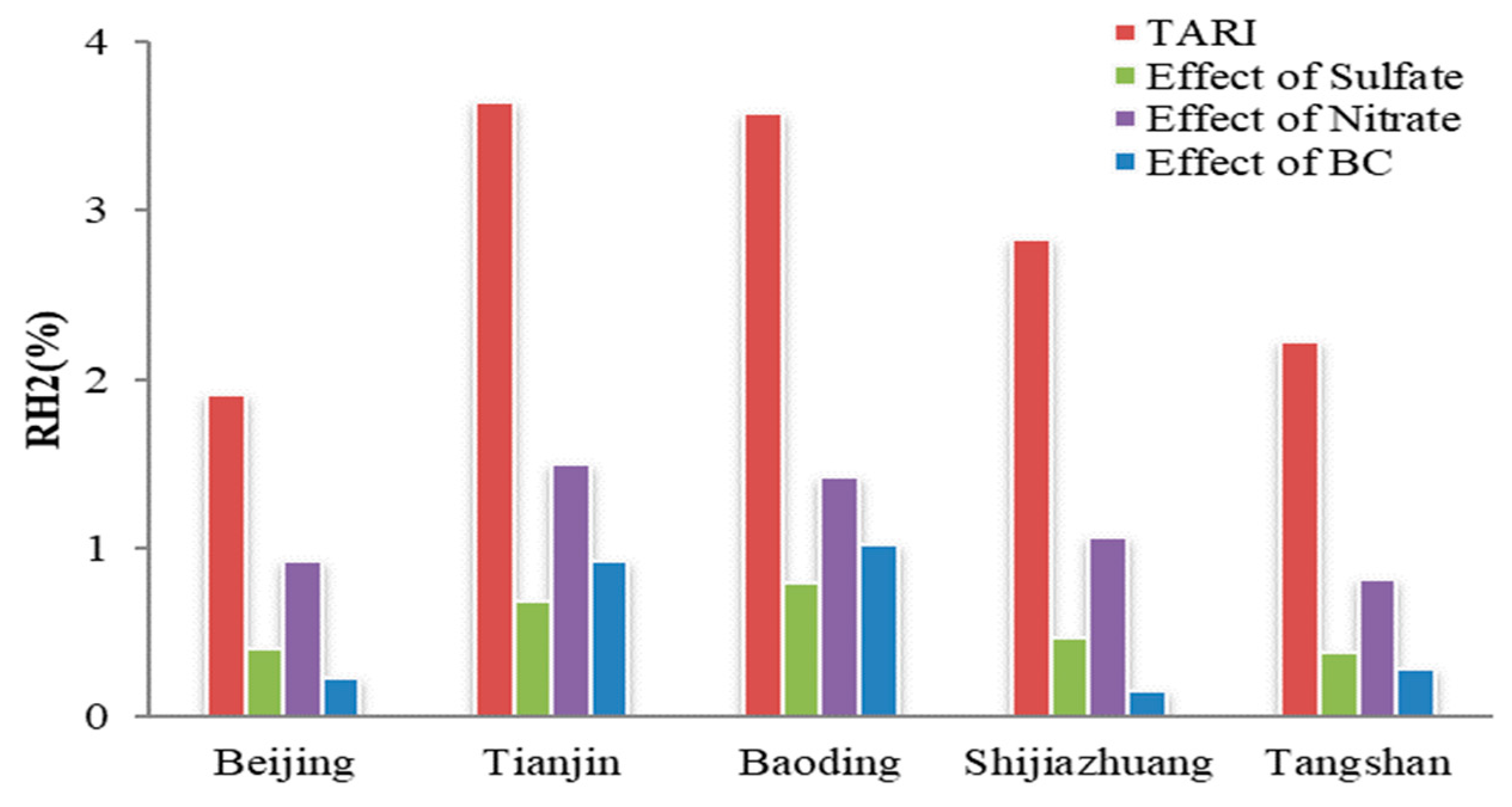
| Physical and Chemical Processes | Scheme |
|---|---|
| Microphysics scheme | New Thompson |
| Shortwave scheme | Goddard |
| Longwave radiation scheme | RRTM |
| PBL scheme | YSU |
| Gas phase chemistry | CBM-Z |
| Aerosol module | MOSAIC |
| Aerosols with shortwave radiation | Mie theory |
| Run | Model Configuration |
|---|---|
| Scenario 1 | Real emission scenario; ARI turned on |
| Scenario 2 | Real emission scenario; ARI turned off |
| Scenario 3 | No NO3− and NOx emissions; ARI turned on |
| Scenario 4 | No SO42− and SO2 emissions; ARI turned on |
| Scenario 5 | No BC emission reduction; ARI turned on |
| Beijing | Tianjin | Baoding | Shijiazhuang | Tangshan | ||
|---|---|---|---|---|---|---|
| T2 (K) | NMB (%) | −1.00 | 1.00 | −0.34 | −0.56 | −0.10 |
| NME (%) | 1.00 | 0.58 | 0.81 | 0.98 | 0.75 | |
| RC | 0.72 | 0.75 | 0.71 | 0.53 | 0.78 | |
| RH2 (%) | NMB (%) | −1.98 | −1.38 | −12.59 | −9.23 | −3.62 |
| NME (%) | 19.35 | 23.07 | 21.22 | 22.63 | 18.05 | |
| RC | 0.68 | 0.59 | 0.64 | 0.68 | 0.74 | |
| WS10 (m s−1) | NMB (%) | 17.90 | 46.42 | 67.44 | 40.59 | 59.27 |
| NME (%) | 61.70 | 69.36 | 69.08 | 60.63 | 70.41 | |
| RC | 0.57 | 0.65 | 0.63 | 0.63 | 0.78 | |
| PM2.5 (μg m−3) | NMB (%) | −41.37 | 24.66 | 28.35 | 30.95 | −34.79 |
| NME (%) | 43.76 | 41.66 | 32.83 | 35.65 | 36.82 | |
| RC | 0.67 | 0.58 | 0.80 | 0.74 | 0.80 |
| SWDOWN (W m−2) | PM2.5 Concentration (μg m−3) | Beijing | Tianjin | Baoding | Shijiazhuang | Tangshan |
|---|---|---|---|---|---|---|
| TARI | >75 | −26.66 | −24.45 | −26.48 | −25.55 | −22.02 |
| <75 | −6.43 | −5.30 | −6.99 | −4.57 | −6.06 | |
| Effect of SO42− | >75 | −6.25 | −5.98 | −5.69 | −5.67 | −3.73 |
| <75 | −0.89 | −0.74 | −1.02 | −0.50 | −0.69 | |
| Effect of NO3− | >75 | −8.47 | −8.40 | −7.45 | −6.42 | −7.33 |
| <75 | −1.25 | −0.83 | −0.94 | −0.41 | −1.39 | |
| Effect of BC | >75 | −12.23 | −8.14 | −14.04 | −13.47 | −11.31 |
| <75 | −3.62 | −3.03 | −4.12 | −2.78 | −3.09 |
| T2 (°C) | PM2.5 Concentration (μg m−3) | Beijing | Tianjin | Baoding | Shijiazhuang | Tangshan |
|---|---|---|---|---|---|---|
| TARI | >75 | −1.24 | −0.94 | −0.98 | −0.86 | −0.70 |
| <75 | −0.32 | −0.35 | −0.29 | −0.17 | −0.28 | |
| Effect of SO42− | >75 | −0.36 | −0.34 | −0.28 | −0.19 | −0.10 |
| <75 | −0.08 | −0.08 | −0.06 | −0.03 | −0.05 | |
| Effect of NO3− | >75 | −0.66 | −0.60 | −0.45 | −0.39 | −0.41 |
| <75 | −0.17 | −0.14 | −0.14 | −0.05 | −0.13 | |
| Effect of BC | >75 | −0.30 | −0.08 | −0.21 | −0.13 | 0.04 |
| <75 | −0.02 | −0.03 | −0.06 | −0.04 | −0.04 |
| PBL (m) | PM2.5 Concentration (μg m−3) | Beijing | Tianjin | Baoding | Shijiazhuang | Tangshan |
|---|---|---|---|---|---|---|
| TARI | >75 | −23.14 | −24.09 | −26.01 | −32.90 | −22.88 |
| <75 | −18.56 | −23.33 | −28.73 | −11.93 | −17.82 | |
| Effect of SO42− | >75 | −4.09 | −4.50 | −2.13 | −8.41 | −4.25 |
| <75 | −3.67 | −0.16 | −8.81 | −4.98 | −4.92 | |
| Effect of NO3− | >75 | −5.41 | −9.98 | −9.04 | −9.37 | −8.78 |
| <75 | −8.99 | −5.19 | −10.72 | −1.67 | −8.23 | |
| Effect of BC | >75 | −7.25 | −2.97 | −8.08 | −13.59 | −7.06 |
| <75 | −0.91 | −0.65 | −10.30 | 2.53 | −1.77 |
| RH (%) | PM2.5 Concentration (μg m−3) | Beijing | Tianjin | Baoding | Shijiazhuang | Tangshan |
|---|---|---|---|---|---|---|
| TARI | >75 | 3.61 | 5.54 | 4.95 | 4.56 | 3.323 |
| <75 | 0.70 | 1.86 | 1.39 | 0.78 | 1.469 | |
| Effect of SO42− | >75 | 0.73 | 1.04 | 1.04 | 0.71 | 0.469 |
| <75 | 0.04 | 0.07 | 0.10 | 0.04 | 0.079 | |
| Effect of NO3− | >75 | 1.50 | 2.14 | 1.94 | 1.71 | 1.135 |
| <75 | 0.43 | 0.79 | 0.57 | 0.28 | 0.588 | |
| Effect of BC | >75 | 1.08 | 1.98 | 1.42 | 0.24 | 0.527 |
| <75 | −0.24 | −0.01 | 0.32 | 0.09 | 0.079 |
© 2020 by the authors. Licensee MDPI, Basel, Switzerland. This article is an open access article distributed under the terms and conditions of the Creative Commons Attribution (CC BY) license (http://creativecommons.org/licenses/by/4.0/).
Share and Cite
Wen, W.; Ma, X.; Guo, C.; Zhao, X.; Xu, J.; Liu, L.; Wu, H.; Zhou, W.; Zhang, Z. The Aerosol-Radiation Interaction Effects of Different Particulate Matter Components during Heavy Pollution Periods in China. Atmosphere 2020, 11, 254. https://doi.org/10.3390/atmos11030254
Wen W, Ma X, Guo C, Zhao X, Xu J, Liu L, Wu H, Zhou W, Zhang Z. The Aerosol-Radiation Interaction Effects of Different Particulate Matter Components during Heavy Pollution Periods in China. Atmosphere. 2020; 11(3):254. https://doi.org/10.3390/atmos11030254
Chicago/Turabian StyleWen, Wei, Xin Ma, Chunwei Guo, Xiujuan Zhao, Jing Xu, Lei Liu, Huacheng Wu, Weiqing Zhou, and Zijian Zhang. 2020. "The Aerosol-Radiation Interaction Effects of Different Particulate Matter Components during Heavy Pollution Periods in China" Atmosphere 11, no. 3: 254. https://doi.org/10.3390/atmos11030254
APA StyleWen, W., Ma, X., Guo, C., Zhao, X., Xu, J., Liu, L., Wu, H., Zhou, W., & Zhang, Z. (2020). The Aerosol-Radiation Interaction Effects of Different Particulate Matter Components during Heavy Pollution Periods in China. Atmosphere, 11(3), 254. https://doi.org/10.3390/atmos11030254






